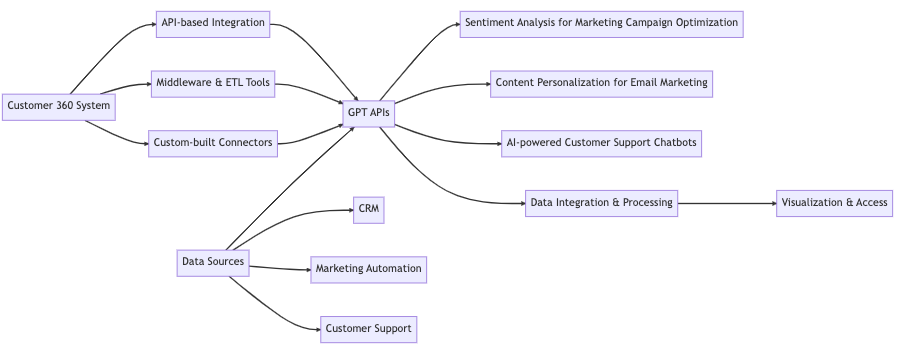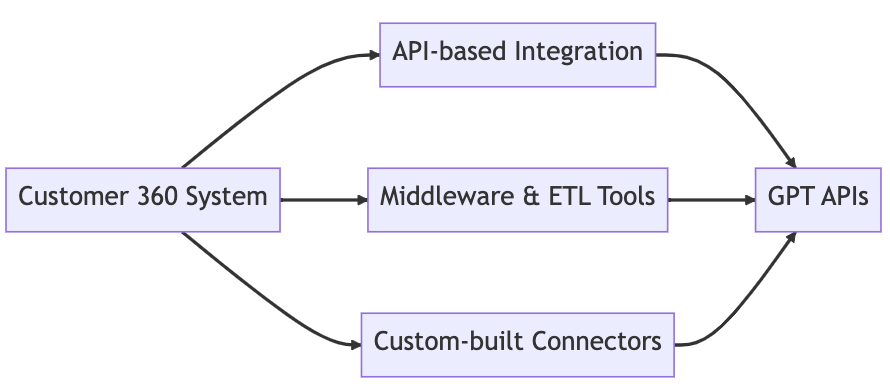Integrating Customer 360 Systems With GPT APIs
Customer 360 is a comprehensive approach to understanding and managing customer data across multiple touchpoints. It is essential for organizations to have a holistic view of their customers’ interactions, preferences, and needs in order to deliver personalized experiences and services. Integrating AI-powered language models like GPT APIs can significantly enhance the capabilities of Customer 360 systems, adding value through natural language processing, text generation, and data analysis. This article dives into the technical architecture of integrating GPT APIs with Customer 360 systems, exploring various integration approaches, architectural components, and use cases.
Understanding GPT APIs
GPT (Generative Pre-trained Transformer) APIs are a set of web services that provide access to powerful AI language models. These models, like OpenAI’s GPT series, have the ability to generate human-like text, analyze content, and make predictions based on input data. In the context of Customer 360 systems, GPT APIs can be used for tasks such as customer sentiment analysis, content generation, and automating customer support responses.
Integration Approaches
1. API-Based Integration
APIs (Application Programming Interfaces) are the primary method for connecting Customer 360 systems with GPT APIs. They provide a standardized way for systems to communicate and exchange data. Key considerations for API-based integration include authentication (using API keys or OAuth), rate limits (to avoid overloading the API service), and data formats (such as JSON or XML).
2. Middleware and ETL Tools
Middleware and ETL (Extract, Transform, Load) tools can be used to facilitate data exchange between Customer 360 systems and GPT APIs. Middleware serves as an intermediary layer that handles communication and data transformation, while ETL tools enable data extraction, transformation, and loading processes. Examples of popular middleware and ETL tools include Workato, Boomi, MuleSoft, Apache NiFi, and Talend.
3. Custom-Built Connectors
Alternatively, organizations can build custom connectors to integrate Customer 360 systems with GPT APIs. Custom connectors can offer more flexibility and control over the integration process but may require more development and maintenance efforts compared to API-based integration or middleware. It’s important to weigh the pros and cons of custom connectors against other integration approaches.
Architectural Components
1. Data Sources
Main data sources for Customer 360 systems include CRM (Customer Relationship Management) systems, marketing automation platforms, and customer support platforms. GPT APIs can be connected to these data sources through APIs or middleware, enabling seamless data exchange and enhancing the system’s capabilities.
2. Data Integration and Processing
Data integration and processing are crucial for creating a unified view of the customer. GPT APIs can be used to analyze and process data from various sources, enriching the insights generated by Customer 360 systems. For instance, GPT APIs can help in sentiment analysis, summarization, and data categorization.
3. Visualization and Access
GPT APIs can also be used to improve the visualization of Customer 360 data and create more accessible interfaces for users. By generating natural language summaries, GPT APIs can make complex data more understandable. Tools and platforms such as Tableau, Power BI, or D3.js can be used for data visualization and access.

Use Cases and Examples
Examples of real-world applications of Customer 360 systems integrated with GPT APIs include sentiment analysis for marketing campaign optimization, content personalization for email marketing, and AI-powered customer support chatbots. These implementations have demonstrated the potential to improve customer experience, reduce response times, and drive business growth. However, organizations should be aware of potential challenges, such as data privacy concerns and the need for ongoing model training and maintenance.
Best Practices and Considerations
When integrating Customer 360 systems with GPT APIs, organizations should consider the following best practices and key considerations:
- Data privacy and security: Ensure that sensitive customer data is handled securely, adhering to data protection regulations such as GDPR and CCPA.
- Scalability: Design the integration architecture with scalability in mind, allowing for growth in data volume and complexity over time.
- Model training and maintenance: Continuously update and fine-tune the GPT models to maintain accuracy and relevance.
- Monitoring and error handling: Implement robust monitoring and error handling mechanisms to ensure the reliability and stability of the integrated system.
- Collaboration: Foster cross-functional collaboration between data scientists, developers, and business stakeholders to align the integration efforts with organizational goals and objectives.
Integrating Customer 360 systems with GPT APIs can unlock new potential for organizations seeking to enhance their customer-centric initiatives. By combining the power of AI-driven language models with a comprehensive view of customer data, businesses can deliver more personalized experiences, improve decision-making, and drive growth. This article has provided insights into the technical architecture, integration approaches, and best practices for integrating GPT APIs with Customer 360 systems. By leveraging these insights, organizations can successfully harness the power of AI to elevate their customer understanding and engagement strategies.
Customer 360 is a comprehensive approach to understanding and managing customer data across multiple touchpoints. It is essential for organizations to have a holistic view of their customers’ interactions, preferences, and needs in order to deliver personalized experiences and services. Integrating AI-powered language models like GPT APIs can significantly enhance the capabilities of Customer 360 systems, adding value through natural language processing, text generation, and data analysis. This article dives into the technical architecture of integrating GPT APIs with Customer 360 systems, exploring various integration approaches, architectural components, and use cases.
Understanding GPT APIs
GPT (Generative Pre-trained Transformer) APIs are a set of web services that provide access to powerful AI language models. These models, like OpenAI’s GPT series, have the ability to generate human-like text, analyze content, and make predictions based on input data. In the context of Customer 360 systems, GPT APIs can be used for tasks such as customer sentiment analysis, content generation, and automating customer support responses.
Integration Approaches
1. API-Based Integration
APIs (Application Programming Interfaces) are the primary method for connecting Customer 360 systems with GPT APIs. They provide a standardized way for systems to communicate and exchange data. Key considerations for API-based integration include authentication (using API keys or OAuth), rate limits (to avoid overloading the API service), and data formats (such as JSON or XML).
2. Middleware and ETL Tools
Middleware and ETL (Extract, Transform, Load) tools can be used to facilitate data exchange between Customer 360 systems and GPT APIs. Middleware serves as an intermediary layer that handles communication and data transformation, while ETL tools enable data extraction, transformation, and loading processes. Examples of popular middleware and ETL tools include Workato, Boomi, MuleSoft, Apache NiFi, and Talend.
3. Custom-Built Connectors
Alternatively, organizations can build custom connectors to integrate Customer 360 systems with GPT APIs. Custom connectors can offer more flexibility and control over the integration process but may require more development and maintenance efforts compared to API-based integration or middleware. It’s important to weigh the pros and cons of custom connectors against other integration approaches.

Architectural Components
1. Data Sources
Main data sources for Customer 360 systems include CRM (Customer Relationship Management) systems, marketing automation platforms, and customer support platforms. GPT APIs can be connected to these data sources through APIs or middleware, enabling seamless data exchange and enhancing the system’s capabilities.
2. Data Integration and Processing
Data integration and processing are crucial for creating a unified view of the customer. GPT APIs can be used to analyze and process data from various sources, enriching the insights generated by Customer 360 systems. For instance, GPT APIs can help in sentiment analysis, summarization, and data categorization.
3. Visualization and Access
GPT APIs can also be used to improve the visualization of Customer 360 data and create more accessible interfaces for users. By generating natural language summaries, GPT APIs can make complex data more understandable. Tools and platforms such as Tableau, Power BI, or D3.js can be used for data visualization and access.

Use Cases and Examples
Examples of real-world applications of Customer 360 systems integrated with GPT APIs include sentiment analysis for marketing campaign optimization, content personalization for email marketing, and AI-powered customer support chatbots. These implementations have demonstrated the potential to improve customer experience, reduce response times, and drive business growth. However, organizations should be aware of potential challenges, such as data privacy concerns and the need for ongoing model training and maintenance.
Best Practices and Considerations
When integrating Customer 360 systems with GPT APIs, organizations should consider the following best practices and key considerations:
- Data privacy and security: Ensure that sensitive customer data is handled securely, adhering to data protection regulations such as GDPR and CCPA.
- Scalability: Design the integration architecture with scalability in mind, allowing for growth in data volume and complexity over time.
- Model training and maintenance: Continuously update and fine-tune the GPT models to maintain accuracy and relevance.
- Monitoring and error handling: Implement robust monitoring and error handling mechanisms to ensure the reliability and stability of the integrated system.
- Collaboration: Foster cross-functional collaboration between data scientists, developers, and business stakeholders to align the integration efforts with organizational goals and objectives.
Integrating Customer 360 systems with GPT APIs can unlock new potential for organizations seeking to enhance their customer-centric initiatives. By combining the power of AI-driven language models with a comprehensive view of customer data, businesses can deliver more personalized experiences, improve decision-making, and drive growth. This article has provided insights into the technical architecture, integration approaches, and best practices for integrating GPT APIs with Customer 360 systems. By leveraging these insights, organizations can successfully harness the power of AI to elevate their customer understanding and engagement strategies.
